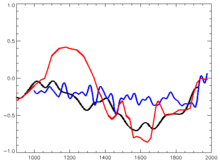Description of the Medieval Warm Period and Little Ice Age in IPCC reports: Difference between revisions
m moved MWP and LIA in IPCC reports to Description of the Medieval Warm Period and Little Ice Age in IPCC reports: More accurate name |
m moved Description of the Medieval Warm Period and Little Ice Age in IPCC reports to IPCC assessment of the Medieval Warm Period and Little Ice Age: They don't really issue reports (in the sense of conducting research) but rather assess the researc |
(No difference)
| |
Revision as of 19:15, 20 March 2007

The description of the Medieval Warm Period and Little Ice Age in IPCC reports has changed since the first report in 1990 as scientific understanding of the temperature record of the past 1000 years has improved. The Medieval Warm Period (MWP) and Little Ice Age (LIA) are the best-known temperature fluctuations in the last millenium.
Critics of the "hockey stick graph" of later reports have claimed that the record of the MWP and LIA were suppressed in the IPCC Third Assessment Report, although every report has discussed the phenomena.
1990 report

With the growth of interest in global warming in the 1980s came renewed interest in the past temperature record, and the question of whether past times had been warmer or colder than "present". However, at this time available records were few. The discussion in chapter 7 "Observed climate variations and change" of the last 1000 years (excluding the instrumental period) occupies less than a page.
A schematic (non-quantitative) curve was used to represent temperature variations over the last 1000 years in chapter 7. The vertical temperature scale was labelled as "Temperature change (°C)" but no numerical labels were given; it could be taken to imply that temperature variations of the MWP and LIA were each of the order of 0.5 °C from the temperature around 1900. The section specifically states recent climate changes were in a range of probably less than 2 °C. The 1990 report noted that it was not clear whether all the fluctuations indicated were truly global (p 202). The graph had no clear source (it resembles figure A9(d) from the 1975 NAS report, which is sourced to Lamb, 1966), and disappeared from the 1992 supplementary report.
Within the 1990 report, the LIA is taken to be global in extent but the MWP is not. Climate over the last 1000 years is mentioned very briefly in the SPM of the 1990 report. The MWP is not mentioned at all, and the LIA described by ...probably fluctuated by little more than 1°C. Some fluctuations lasted several centuries, including the LIA which ended in the [19th century] and which appears to have been global in extent. The MWP is mentioned in the executive summary to chapter 7, as MWP around 1000 AD (which may not have been global).
1992 supplement
The 1992 report (appendix C) used only two graphs or pre-instrumental temperatures, from Wang and Wang (1991). They show air temperature based on documentary evidence in East and North China from 1350-1950. Fluctuations are of the order of 0.5-0.75 °C and indicate, variably, colder-than-present temperatures before the 20th century. The graph stops in 1350 and does not show a MWP. The only text reference to the MWP is qualified by in this region in boldface.
1995 report (SAR)
By 1995, research in the subject had advanced and hemispherical reconstructions of temperature were available, though only for the summer season (because tree rings are often most strongly influenced by summer temperatures). The 1995 IPCC report used a northern hemisphere summer temperature reconstruction (fig 3.20) from 1400 to 1979 by Bradley and Jones (1993). This too shows no MWP (it only goes back to 1400) and colder temperatures otherwise before the 20th century, of the order of 0.5 °C colder. Fig 3.21 shows 8 ice core records from 1200 to present, which display a mixed pattern. The MWP and LIA are introduced, in the text, as two periods which have received special attention... These have been interpreted, at times, as periods of global warmth and coolness, respectively. Recent studies have re-evaluated the interval commonly known as the MWP... the available evidence is limited (geographically) and is equivocal.
2001 report (TAR)
The 2001 report used northern hemisphere warm-season and annual reconstructions from 1000 AD to present by Mann et al (1999), Jones et al (1999) and Briffa (2000) [1].
The IPCC TAR says of the MWP that the posited Medieval Warm Period appears to have been less distinct, more moderate in amplitude, and somewhat different in timing at the hemispheric scale than is typically inferred for the conventionally-defined European epoch. The Northern Hemisphere mean temperature estimates of Jones et al. (1998), Mann et al. (1999), and Crowley and Lowery (2000) show temperatures from the 11th to 14th centuries to be about 0.2°C warmer than those from the 15th to 19th centuries, but rather below mid-20th century temperatures [2].
The TAR discusses Was there a "Little Ice Age" and a "Medieval Warm Period"? and says Thus current evidence does not support globally synchronous periods of anomalous cold or warmth over this timeframe, and the conventional terms of "Little Ice Age" and "Medieval Warm Period" appear to have limited utility in describing trends in hemispheric or global mean temperature changes in past centuries.[2]
